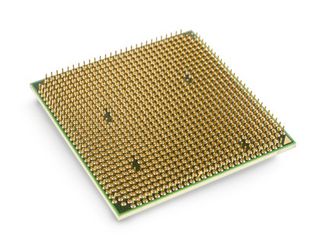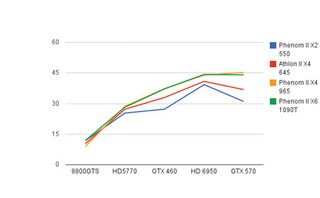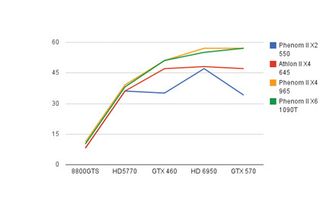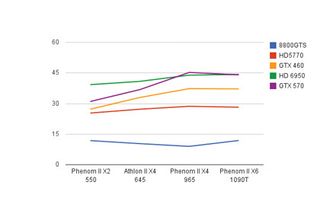The best PC upgrades for gamers
Top graphics cards, processors and more

There are certain phrases that are irrelevant if not completely meaningless to a PC gamer. Phrases like 'press start to continue' and 'I don't care about frame rates' are just two.
The most meaningless to us, though, is the oft-heard phrase 'if it ain't broke don't fix it.' Frankly, we can't help ourselves, but thanks to the unique way in which the PC has evolved we can get elbow-deep in printed circuit boards and really make a difference to our favourite games.
The age-old bastion of PC gaming has been the ability to replace key components of your machine as and when required to gain extra frame rates in the latest games. For a long time it was all about the CPU itself, and to a lesser extent the amount of RAM available, but with the advent of 3D gaming and the graphics accelerator card, the GPU has become just as vital to a smooth-running gaming rig.
Beating the bottleneck
But all along it's been about identifying bottlenecks in your system in order to pursue that Holy Grail of PC-dom: the balanced PC. Only a well-balanced machine will give you the full use of every component in your rig, and when you've spent £300 on a new graphics card you don't want to find out your CPU is making it work at only 50 per cent of its potential.
And that's why we're here, to stop you making impulsive purchases without thinking through the consequences.
We've picked two machines, representing rigs from both Intel and AMD camps that would've been fairly decent gaming PCs a couple of years ago, and we've tested a whole host of new components in each to discover the best PC upgrades.
But first...
There's a couple of caveats, though - aren't there always? The cheapest upgrade for any PC right now is to throw more RAM at it. After all, for £50 you can pick up 4GB of fast DDR3. But if you're after gaming performance enhancements anything above 2GB really isn't going to deliver anything in terms of frame rates.
General Windows performance will feel better, however, but only then if you're running a 64-bit operating system. And speaking of 64-bit operating systems, a rig from a couple of years ago wouldn't have come with Windows 7, oh no, you'd have been stuck with the mark of Vista, and probably the 32-bit version too.
Now most of us have made the move over to Windows 7 64-bit, according to the latest Steam Hardware Survey 41 per cent of us are running Win7 64-bit, with 22 per cent still operating in the dark ages of XP. Only 13 per cent are stuck in the Vista doldrums, so we're going to assume the OS upgrade has been made already.
So with that boring software shizzle out of the way, what do we do about getting some new hardware jammed into the confines of our beautiful gaming PCs?
AMD base rig

Motherboard: Asus M4A78T-E
CPU: AMD Athlon II X2 550 Black Edition
RAM: 2GB DDR3
Graphics: Nvidia GeForce 8800GTS
Processor upgrade

We've got three upgrade options on offer for this here AMD rig. Thanks to its AM3 pedigree the upgrade path is laid out before us like the yellow-brick road, meaning we can just drop in any modern AMD processor we happen to fancy.
Chip choice
The starting point is the dual-core Phenom II X2 550 BE, then we can see what another couple of CPU cores gives us with the Athlon II X4 645 quad. Moving ever upwards there's the similarly quad-core, but faster and L3 cache-heavy Phenom II X4 965 BE, followed closely by the hex-core Phenom II X6 1090T BE.
So we've got a wide range of processors on offer, but you can see that by purely upgrading the CPU itself you are seriously limited by the power on offer with the Nvidia 8800GTS. In its day it was an effective mid-range DirectX 10 card, now it's stopping any upgrade in its tracks.
Only the processor-intensive World in Conflict shows any improvement going all the way up to top chips, and only then by a max 3fps. Weak, huh? But that's just gaming. If you load up any processor specific benchmarks, such as the 3D rendering Cinebench or video encoding x264, you can see how much the raw computational performance of the upgraded CPUs increases.
As you'd expect the Phenom II X6 is around three times faster than the lowly dualie in the base AMD system with the 8800GTS. This highlights just how hobbled the CPU is in terms of gaming performance by a weak graphics card. You can see how wasted that makes the cash you'll spend on a CPU upgrade alone.
Benchmarks
DX10 gaming: Just Cause 2

Graphics upgrade

The news is a little better when it comes to a simple graphics card update, and that's thanks to the fairly decent gaming prowess of the wee Phenom II X2 550 BE. It's by no means an excellent gamer's CPU, but it's still got enough about it in terms of keeping the speedier graphics cards filled with a fair few frames.
We've chosen four graphics card upgrades: the sub-£100 budget choice in the HD 5770, the sub-£150 GTX 460, the £220 mid-range hero HD 6950 and the wallet-paining £300 GTX 570.
The biggest jump in performance comes in the form of the initial budget-conscious upgrade. The XFX HD 5770 pairs up brilliantly with the Phenom II X2 - both AMD parts incidentally - instantly giving playable frame rates at the 22-inch native resolution of 1,680 x 1,050. It's a huge jump in performance, and for less than £100 you've instantly got a far more relevant games machine.
You get a similar jump in performance swapping in the other AMD card, the Sapphire Radeon HD 6950.
The performance of the two Nvidia cards shows how reliant those cards are on powerful CPUs to keep them fed. Generally, the Zotac GTX 460 gives a few extra frames over the HD 5770 but not enough to justify the extra £60 for the pleasure, and when it comes to the hugely expensive Zotac GTX 570 you can see just how limited you are by the weaker CPU. So, time to balance the graphics card and your processor then, huh?
Benchmarks
DX10 gaming: World in Conflict

The AMD upgrade

You've got to love AMD. It's the little guy compared with Intel's monster corporation. Don't get us wrong: it's no bedroom-office outfit, but it operates on a shoestring compared to Intel's huge R&D budget.
It's this reason we've still seeing essentially the same CPU cores that were introduced with the Hammer architecture in 2003, which is why the sockets have hardly changed. A couple of years ago AMD introduced the AM3 socket with DDR3 support and since then we've seen slightly new iterations of motherboards, with new Southbridge architecture, but still most AM3 motherboards will accept AMD's entire range of AM3 CPUs.
Importantly, that runs right up to the finest on offer: the Phenom II X6 hex-core range, with it's latest Thuban cores.
More frames please
Now we've seen just how little it can mean in gaming performance terms if you just upgrade the CPU on its own. If you're into your 3D rendering or video encode all hours of every day then upgrading the CPU on its own will certainly make a hell of a difference, but we're gamers and we want extra frame rates for the upgrade cash we're spending.
On the graphics side once more it's all about AMD. Drop an £82 HD 5770 into the mix and all of a sudden you've got a rig that's once more capable of giving you a decent gaming experience. Even a significantly more expensive HD 6950 plays nice with the dual-core Phenom II.
The Nvidia cards on the other hand prove just how desperate they are for a serious CPU partner. The Athlon II X4 645 does a good job of trying to give them the power they crave. Thanks to the four cores on offer the GTX 460 suddenly looks like the card we know and love, though again the CPU starts to limit the graphics cards further up the food chain.
Indeed, with World in Conflict there's little performance difference between the GTX 460, HD 6950 or the GTX 570.
Level up
In terms of a good budget pairing then, the GTX 460 and Athlon II X4 645 make for a winning combination. For a combined cost of £195 you've got a rig capable of topping 30fps across the board with 4x anti-aliasing thrown in for good measure in most modern games.
The Phenom X4 and X6 CPUs, however, represent the pinnacle of the AMD upgrade mountain and are processors with serious gaming grunt, putting clear water between themselves and the cheaper processing competition. In terms of raw computational grunt the Phenom II X6 is almost on par with the superlative Core i5 2500K, though in the gaming world those extra two cores make little difference compared with the quad-core Phenom II X4.
It's interesting, though, just how poorly the GTX 570 fares with AMD processors. It's only the notoriously Nvidia-centric DiRT2 benchmark that gives the most expensive card in our test the lead, though admittedly by a clear margin.
In the other tests the £320-odd Phenom II X4 965 and HD 6950 pairing is tops. Though for another £40 extra on top of the price of the quad-core Phenom II X4, there are six cores on offer for those who like to dabble in a little productivity too.
Benchmarks
DX11 gaming DiRT 2

Final analysis: Finding the balance

Get daily insight, inspiration and deals in your inbox
Get the hottest deals available in your inbox plus news, reviews, opinion, analysis and more from the TechRadar team.
